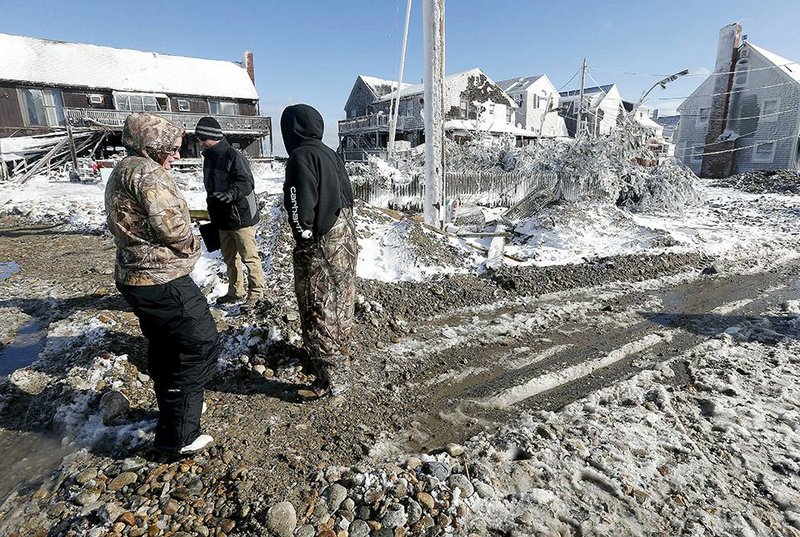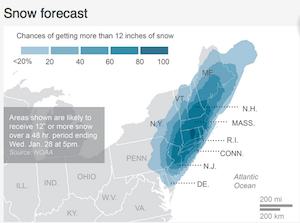BOSTON -- Boston bounced back quickly Wednesday from the blizzard of 2015, with subways, buses and trains up and running again the morning after the storm buried portions of New England in 2 feet to 3 feet of snow.
Many businesses reopened, as did Logan Airport, and homeowners, motorists and storekeepers dug out with grudging praise for the forecasters, who missed the mark in New York but got it right in New England.
Chris Laudani, a Boston bartender, became an instant symbol of the city's resilience for shoveling snow off the yellow and blue Boston Marathon finish line on Boylston Street, where the 2013 terrorist bombing killed three people and wounded more than 260.
Meteorologists had warned that Boston would get more than 2 feet of snow by Tuesday night, and the National Weather Service said the city ended up with 24.4 inches, the sixth-highest total on record. Other areas received around 2 feet to 3 feet, pretty much as predicted.
"They actually got it right," James Hansen said as he cleared a Boston sidewalk.
There was no gloating among the forecasters themselves, who just seemed relieved they were on the money.
Pointing up the guesswork factor, the weather team at Boston's WHDH-TV tweeted a photo of the office "snow pool," with pre-storm predictions ranging from 22 inches to 25.5 inches.
As the storm gathered earlier in the week, forecasters had warned that Philadelphia, New York and New Jersey could get 1 foot to 2 feet of snow. But in the end, they didn't even see a foot.
With snow removal in Boston underway, commuters high-stepped their way through a warren of snowy paths and towering snowbanks that gave the capital an almost alpine feel.
Still, bitter cold threatened to complicate efforts to clear clogged streets and restore power. Forecasters warned that it won't get above freezing in Boston for a week, and several more inches of snow are expected Friday and again over the weekend.
Boston is accustomed to big snowstorms, and with ample warning that a blizzard was on the way, officials mobilized thousands of snowplows and called up the National Guard.
Early on, Gov. Charlie Baker, who has been in office just three weeks, made a key decision, ordering a driving ban to give crews a chance to clear the mounting snow. Baker said he wrestled with that, but it "worked pretty much as we hoped."
"We've come out of this in relatively good shape," he said Wednesday before visiting the hard-hit South Shore area, where the storm punched a gaping hole in a seawall and caused flooding.
Baker also took a helicopter to Nantucket, where islanders accounted for about half the 7,200 people in Massachusetts still without electricity. Nantucket was lashed with winds gusting to 76 mph.
Around Massachusetts, Worcester got 33.5 inches -- the highest amount recorded since 1905 -- and Auburn and Lunenburg each reported 36 inches.
Parts of the New Hampshire coastline got 31 inches. Providence, R.I., received around 19 inches. Thirty-one inches piled up in Sanford, Maine, and 33.5 inches in Thompson, Conn. Orient, on the eastern end of New York's Long Island, got about 30 inches.
"Our snowblower broke down a couple of times because it couldn't handle all the snow," said Jodi McKim, struggling to free her car in Whitman, south of Boston.
A 53-year-old man collapsed and died in New Bedford, Mass., while shoveling snow Tuesday night, officials said. Two other deaths, both on Long Island, were blamed on the storm.
In Providence, a man and his two small children were hospitalized with suspected carbon monoxide poisoning after drifting snow covered a boiler vent on their home.
In rural Maine, Leo Moody hoped to dig his ice-fishing shack out of the snow. With the blase tone of a genuine Downeaster, he brushed it all off as "just a snowstorm."
"Back in the '70s and '80s, this was a typical winter," Moody said. "Now you get a couple feet of snow and everybody freaks out."
Scientists caution against linking any one weather event to man-made global warming without lengthy and intricate analysis.
But the waters off the Northeast were about 2 degrees warmer than normal, and last year the world regularly broke ocean temperature records, said Jeff Masters at Weather Underground.
He and other experts say that as the world warms, stronger storms can be expected because warmer water supplies the storms with more energy and warmer air allows them to hold and dump more snow or rain.
Information for this article was contributed by Steve LeBlanc, Rodrique Ngowi, Mark Pratt, Philip Marcelo, Michelle R. Smith, Seth Borenstein, Denise Lavoie and Alanna Durkin of The Associated Press.
A Section on 01/29/2015

